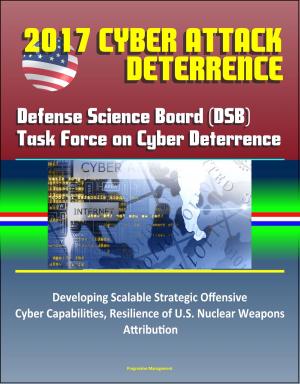Here to Help: Third Party Deterrence Against Insurgent Groups - State Centrism, Nuclear Prominence, and Congruent Relationships, Denial, Delegitimization, Case Study of Boko Haram, Nigeria and America
Nonfiction, History, Military, United States, Social & Cultural Studies, Political Science| Author: | Progressive Management | ISBN: | 9781370186037 |
| Publisher: | Progressive Management | Publication: | March 2, 2017 |
| Imprint: | Smashwords Edition | Language: | English |
| Author: | Progressive Management |
| ISBN: | 9781370186037 |
| Publisher: | Progressive Management |
| Publication: | March 2, 2017 |
| Imprint: | Smashwords Edition |
| Language: | English |
This excellent report has been professionally converted for accurate flowing-text e-book format reproduction. During the Cold War, both the United States and the Soviet Union exercised third party deterrence to protect key allies against hostile aggression. However, since the end of World War II, violent non-state groups such as terrorists, insurgents, and criminal organizations represent the predominant security threats to states. This monograph argues that third party deterrence is a valid concept applied against an insurgent group challenging a partner state. This monograph analyzes three key variables of Cold War deterrence—state centrism; nuclear prominence; and congruent relationships. Recognizing the evolution of those variables since the end of the Cold War unlocks deterrence methods not just limited to threats of punishment, but of deterrence through denial and delegitimization. Deterring an insurgent or potential insurgent group through delegitimization is a powerful approach, but it requires the third party state to apply coercive force against both the insurgent group and the partner state's government.
Is deterrence still relevant in the contemporary operating environment? With a few exceptions, deterrence was at the foundation of order during the bipolarity of the Cold War era. The United States and the Soviet Union built alliances, nuclear stockpiles, and even anti-ballistic missile systems, signaling to each other the potential consequences of taking aggressive military action against them or their friends. The fear of punishment or retaliation was the language of deterrence. However, in the current world where the vast majority of armed conflicts since World War II occur within national borders, and arguably the most urgent security concerns arise from violent non-state groups unfazed by threats of punishment, deterrence as a strategy seems anachronistic and impractical. Nevertheless, the term "deterrence" remains a fixture in US strategic planning documents and generally applicable to all types of potential enemies.
Between two adversarial states, the traditional idea of deterrence—threatening punishment through retaliation centered around military capabilities and a willingness to use them—mostly endures. However, third party or "extended deterrence" where a state attempts to deter attacks against an ally, is more dubious than during the Cold War given the preponderance of violent non-state groups that threaten states now. Insurgencies, in particular, which Phil Williams defines as "an organized, armed political struggle whose goal may be the seizure of power through revolutionary takeover and replacement of the existing government," have proven extremely resilient and tough to defeat.
This excellent report has been professionally converted for accurate flowing-text e-book format reproduction. During the Cold War, both the United States and the Soviet Union exercised third party deterrence to protect key allies against hostile aggression. However, since the end of World War II, violent non-state groups such as terrorists, insurgents, and criminal organizations represent the predominant security threats to states. This monograph argues that third party deterrence is a valid concept applied against an insurgent group challenging a partner state. This monograph analyzes three key variables of Cold War deterrence—state centrism; nuclear prominence; and congruent relationships. Recognizing the evolution of those variables since the end of the Cold War unlocks deterrence methods not just limited to threats of punishment, but of deterrence through denial and delegitimization. Deterring an insurgent or potential insurgent group through delegitimization is a powerful approach, but it requires the third party state to apply coercive force against both the insurgent group and the partner state's government.
Is deterrence still relevant in the contemporary operating environment? With a few exceptions, deterrence was at the foundation of order during the bipolarity of the Cold War era. The United States and the Soviet Union built alliances, nuclear stockpiles, and even anti-ballistic missile systems, signaling to each other the potential consequences of taking aggressive military action against them or their friends. The fear of punishment or retaliation was the language of deterrence. However, in the current world where the vast majority of armed conflicts since World War II occur within national borders, and arguably the most urgent security concerns arise from violent non-state groups unfazed by threats of punishment, deterrence as a strategy seems anachronistic and impractical. Nevertheless, the term "deterrence" remains a fixture in US strategic planning documents and generally applicable to all types of potential enemies.
Between two adversarial states, the traditional idea of deterrence—threatening punishment through retaliation centered around military capabilities and a willingness to use them—mostly endures. However, third party or "extended deterrence" where a state attempts to deter attacks against an ally, is more dubious than during the Cold War given the preponderance of violent non-state groups that threaten states now. Insurgencies, in particular, which Phil Williams defines as "an organized, armed political struggle whose goal may be the seizure of power through revolutionary takeover and replacement of the existing government," have proven extremely resilient and tough to defeat.















